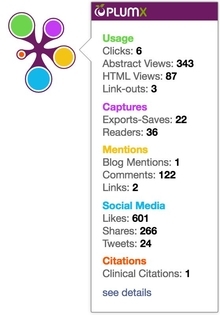Altmetrics, or alternative metrics, go beyond the traditional means of measuring the impact of scholarly works via citations by analyzing mentions in social media, blogs, news outlets, and more. Unlike traditional metrics that can take years to show impact, altmetrics allow for more immediate analysis of impact.
Although altmetrics are often thought of as metrics about articles, they can be applied to journals, books, data sets, presentations, videos, source code repositories, web pages, etc. Altmetrics use public APIs across platforms to gather data with open scripts and algorithms. Altmetrics calculate scholar impact based on signs of impact such as usage (downloads, clicks, patents, syllabi, etc.), captures (bookmarks, favorites), mentions (new articles, blog posts, Wikipedia references), and social media (Tweets, shares, likes, comments). They demonstrate both the impact and the detailed composition of the impact.
Altmetrics should be used to complement traditional metrics and not used alone. When using altmetrics, exercise caution as sharing does not equal quality or include context. For example, an article could be shared due to its poor or biased research. Altmetrics often focus on what is popular at the moment; historically seminal works may be missed. Additionally, altmetrics can be abused by individuals who want to artificially increase their scores.
PlumX Metrics provide insights into the ways people interact with research. Metrics are displayed using the PlumX Wheel which places activity into five categories: Usage, Captures, Mentions, Social Media, and Citations. Hovering on any PlumX WHeel provides detailed information on each of these categories. The example below indicates that most activity has occurred in the category of Usage followed by Social Media. PlumX Metrics are available on many library databases including EBSCO products and Elsevier products including Scopus.

Altmetric provides an Altmetric Attention Score that measures how much and the types of attention a work has received using a graphic “donut.” The Attention Score is a weighted score that looks at volume, source, and author. A mention in a newspaper will receive more weight than a tweet. Each color in the Altmetric donut represents a different source of attention. For example, red indicates mentions in news sources and yellow indicates blog activity. In the example below, the research has received most mentions in news outlets. See the Altmetric Attention Score for more details on these numbers. Altmetric’s Bookmarklet for Researchers browser plug-in provides article-level metrics for any article you are currently reading.

Part of the Public Library of Science (PLOS), ALM provides both academic and social metrics for its open source journals. ALM draws information from several sources including views in PubMed, saves in Mendeley, citations in Scopus and Web of Science, and mentions in different social media platforms.
